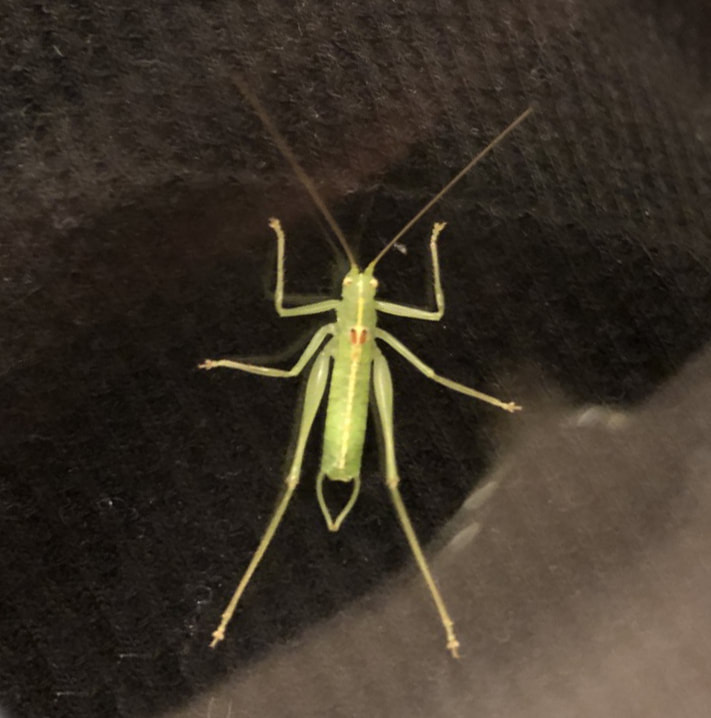Dark Bush-cricket (Pholidoptera griseoaptera)
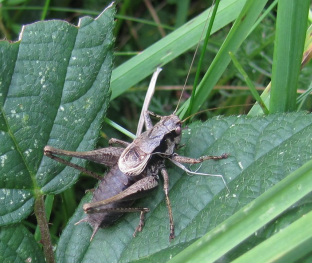
Worcestershire status: Common in southern half.
UK status: Widespread throughout England and Wales but becoming coastal north of the Midlands. Rare in southern Scotland.
Habitat preferences: Wide rides and glades in woodland. Old hedgerows with good herbage. Scrub.
Notes: Very common in good habitat, especially in the south but abscent from many areas in the north.
UK status: Widespread throughout England and Wales but becoming coastal north of the Midlands. Rare in southern Scotland.
Habitat preferences: Wide rides and glades in woodland. Old hedgerows with good herbage. Scrub.
Notes: Very common in good habitat, especially in the south but abscent from many areas in the north.
Roesel's Bush-cricket (Metrioptera roeselii)
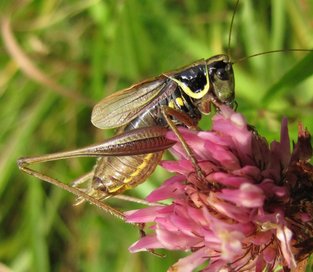
Worcestershire status: Common and rapid range expansion.
UK status: Spreading rapidly from south east England.
Habitat preferences: Any long grass with thistles or rushes.
Notes: The first record for this species in Worcestershire is from Redditch in 2005. Since then it has spread rapidly across the county to most areas.
UK status: Spreading rapidly from south east England.
Habitat preferences: Any long grass with thistles or rushes.
Notes: The first record for this species in Worcestershire is from Redditch in 2005. Since then it has spread rapidly across the county to most areas.
Bog Bush-cricket (Metrioptera brachyptera)
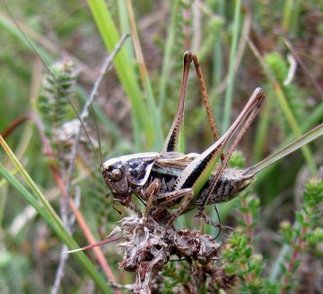
Worcestershire status: Unlikely to occur.
UK status: Widespread in England and Wales but absent from many counties due to habitat preferences.
Habitat preferences: Damp heathland and moorland.
Notes: Present in adjacent counties where appropriate habitat exists. A single undetermined record from Bredon Hill in Worcestershire.
UK status: Widespread in England and Wales but absent from many counties due to habitat preferences.
Habitat preferences: Damp heathland and moorland.
Notes: Present in adjacent counties where appropriate habitat exists. A single undetermined record from Bredon Hill in Worcestershire.
Speckled Bush-cricket (Leptophyes punctatissima)
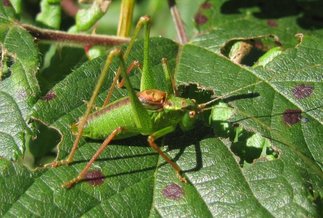
Worcestershire status: Widespread and increasing its range.
UK status: Widespread in Wales and southern England becoming less common further north. Found in south west Scotland.
Habitat preferences: Scrub. Nettle beds. Woodland rides and glades.
Notes: A common but secretive species that is often overlooked.
UK status: Widespread in Wales and southern England becoming less common further north. Found in south west Scotland.
Habitat preferences: Scrub. Nettle beds. Woodland rides and glades.
Notes: A common but secretive species that is often overlooked.
Oak Bush-cricket (Meconema thalassinum)
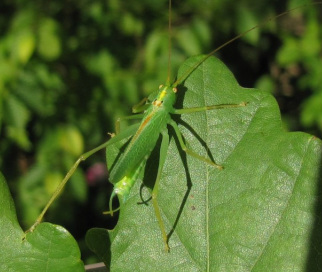
Worcestershire status: Common.
UK status: Common in southern England, the Midlands and Wales. Found as far north as Yorkshire and Lancashire.
Habitat preferences: Woodland. Trees and shrubs including gardens.
Notes: An arboreal species so often overlooked. Never seen in large numbers. Flies well and drawn to light; a habit which brings it into houses at night giving its alternative name of the bathroom bushcricket !
UK status: Common in southern England, the Midlands and Wales. Found as far north as Yorkshire and Lancashire.
Habitat preferences: Woodland. Trees and shrubs including gardens.
Notes: An arboreal species so often overlooked. Never seen in large numbers. Flies well and drawn to light; a habit which brings it into houses at night giving its alternative name of the bathroom bushcricket !
Southern Oak Bush-cricket (Meconema meridionale)
|
Worcestershire status: Newly established. First recorded in Barbourne, Worcester in 2019. UK status: Newly established in Britain since 2001. Spreading rapidly. Habitat preferences: Trees and shrubs including gardens. Possibly hitch-hiking on lorries and have been found in trees around industrial eststates. Notes: Wingless, so most likely spreading in garden plants and hitch-hiking on vehicles and in produce. |
Long-winged Conehead (Conocephalus discolor)
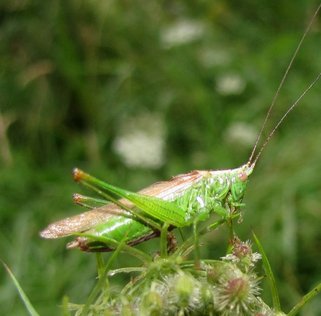
Worcestershire status: Common and rapid range expansion.
UK status: Was a rare insect (Notable a) until recently but is now spreading rapidly from southern England.
Habitat preferences: Any long grass could hold this species.
Notes: First recorded in Worcestershire Near Upton on Severn in 2003 and now found in most areas except the far north of the county.
UK status: Was a rare insect (Notable a) until recently but is now spreading rapidly from southern England.
Habitat preferences: Any long grass could hold this species.
Notes: First recorded in Worcestershire Near Upton on Severn in 2003 and now found in most areas except the far north of the county.
Short-winged Conehead (Conocephalus dorsalis)
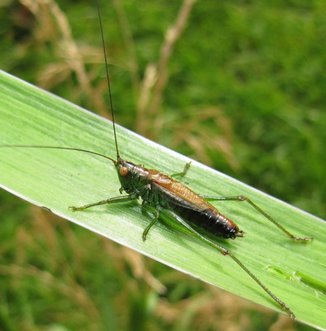
Worcestershire status: Rare but increasing.
UK status: Local in southern England. Coastal locations up to Merseyside with some inland records.
Habitat preferences: Marsh with abundant rushes.
Notes: Restricted by habitat type and site management. Has been found in parkland in long grass with large patches of rushes.
UK status: Local in southern England. Coastal locations up to Merseyside with some inland records.
Habitat preferences: Marsh with abundant rushes.
Notes: Restricted by habitat type and site management. Has been found in parkland in long grass with large patches of rushes.
Great Green Bush-cricket (Tettigonia viridissima)
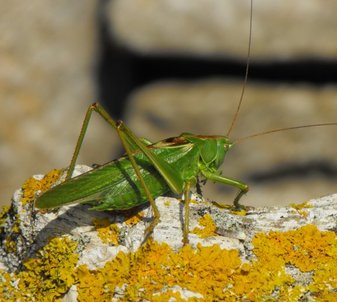
Worcestershire status: One confirmed record in 2014.
UK status: Local in southern England and Wales. Mostly coastal counties but spreading through the Cotswolds.
Habitat preferences: Scrub, bramble and other rough herbage.
Notes: Only one confirmed record in Worcesterhire, from Longdon Marsh in 2014.
Eight undetermined records from between 1947 and 1951 were wrongly transcribed from Fred Fincher's notebooks. Three further undetermined records between 1976 and 1981 are all considered to be mostly mis-identifications (of Oak Bush-cricket?).
UK status: Local in southern England and Wales. Mostly coastal counties but spreading through the Cotswolds.
Habitat preferences: Scrub, bramble and other rough herbage.
Notes: Only one confirmed record in Worcesterhire, from Longdon Marsh in 2014.
Eight undetermined records from between 1947 and 1951 were wrongly transcribed from Fred Fincher's notebooks. Three further undetermined records between 1976 and 1981 are all considered to be mostly mis-identifications (of Oak Bush-cricket?).
Mole Cricket (Gryllotalpa gryllotalpa)
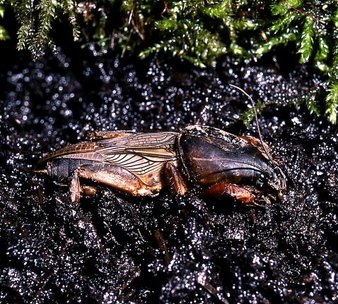
Worcestershire status: Extinct.
UK status: Extinct as a native (?)
Habitat preferences: Wet meadows. Gardens and allotments.
Notes: Only four records between 1902 and 1985 from Worcestershire and an erroneous report from the Malverns incorrectly transcribed from old field notes.
UK status: Extinct as a native (?)
Habitat preferences: Wet meadows. Gardens and allotments.
Notes: Only four records between 1902 and 1985 from Worcestershire and an erroneous report from the Malverns incorrectly transcribed from old field notes.
Wood Cricket (Nemobius sylvestris)
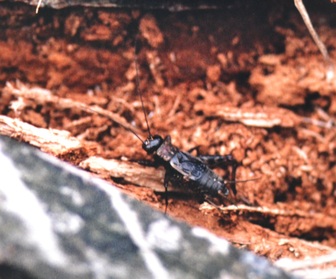
Worcestershire status: Absent.
UK status: Notable A. A rare insect confined to a few open woodlands along the south coast from Surrey to Devon including the New Forest. Also known from the Isle of Wight.
Habitat preferences: Open woodland, leaf litter, bracken.
Notes: Only Worcestershire record is an unconfirmed single juvenile from Shrawley Wood in 1949.
UK status: Notable A. A rare insect confined to a few open woodlands along the south coast from Surrey to Devon including the New Forest. Also known from the Isle of Wight.
Habitat preferences: Open woodland, leaf litter, bracken.
Notes: Only Worcestershire record is an unconfirmed single juvenile from Shrawley Wood in 1949.
House Cricket (Acheta domesticus)
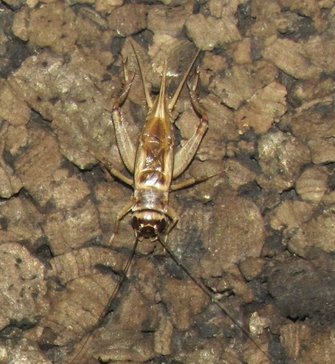
Worcestershire status: Very Rare. Once a frequent colonist of basements and houses; virtually eradicated during the 1960s and 1970s with the last few individuals reported late in the early 2000s until a self-sustaining population was reported from buidings near Bewdley early 2014.
UK status: Occasional records throughout England and Wales. Populations occasionally building up at waste sites and incinerators.
Habitat preferences: Inside buildings. Waste tips.
Notes: No longer used by the pet trade as reptile food. Unlikely to become established outside of buildings in the county. The presence of the Bewdley population shows that they may turn up in heated buildings.
UK status: Occasional records throughout England and Wales. Populations occasionally building up at waste sites and incinerators.
Habitat preferences: Inside buildings. Waste tips.
Notes: No longer used by the pet trade as reptile food. Unlikely to become established outside of buildings in the county. The presence of the Bewdley population shows that they may turn up in heated buildings.
